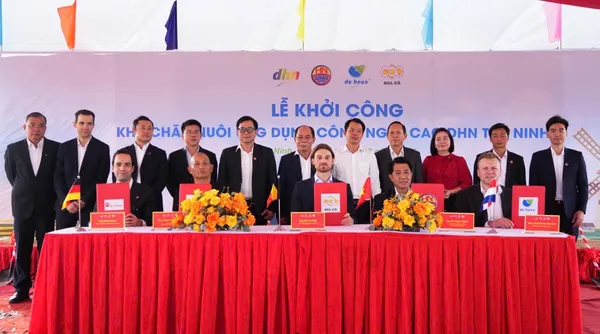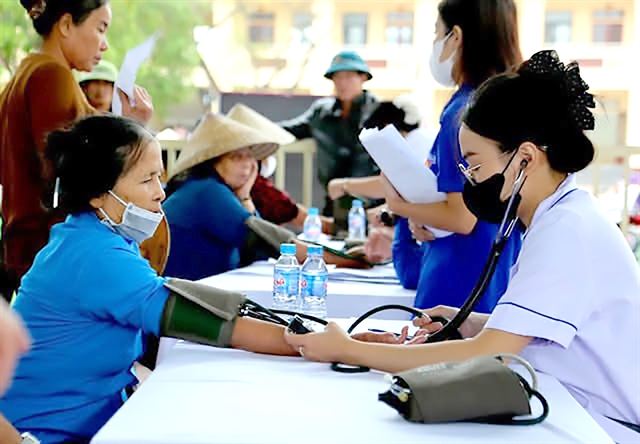 Life & Style
Life & Style

Artists and cultural groups are working to encourage Vietnamese men to wear áo dài, the famous Vietnamese traditional long dress.
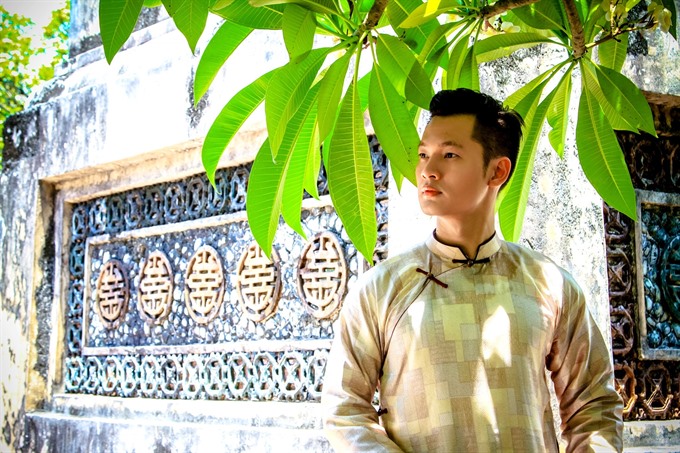 |
| Singer Đức Tuấn in a modern áo dài. Photo bestie.vn |
HÀ NỘI – Artists and cultural groups are working to encourage Vietnamese men to wear áo dài, the famous Vietnamese traditional long dress.
“This year, both women and men are wearing áo dài in our annual events,” researcher Nguyễn Đức Bình told the Việt Nam News.
A few days ago, Bình led a group of 50 people--mostly members of Đình Làng Việt (Vietnamese Communal House) organisation--to gather at the So Village Communal House, nearly 20km west of Hà Nội’s centre, to make a video clip on communal housing values.
“Ambassador Phạm Sanh Châu, the Foreign Minister’s Assistant, initiated the idea and joined our clip,” Bình said. The video is part of a broader campaign to keep traditional dress and values alive.
In HCM City, Đại Việt Cổ Phong, a group specialising in ancient Vietnamese culture, is offering an áo dài tailoring service.
Some enterprises in the City have contracted the group to make áo dài for staff uniforms.
Recently, áo dài have been popular among male singers as well.
“I received lots of encouragement from South Korean audience when I wore a traditional long dress for a man,” singer Hàn Thái Tú told Thanh Niên (Young People) newspaper after he returned from his recent South Korean trip.
Singer Đức Tuấn, who always wears simple decorated long dress, confirmed: “This Tết, I will wear áo dài to perform at music shows.”
Áo dài designer Sỹ Hoàng guessed this lunar new year, more men will wear áo dài when visiting Nguyễn Huệ Flower Street.
“I always encourage my friends in Sài Gòn Businessmen’s Club to wear áo dài,” he said.
Vi Kiến Thành, head of Fine Arts, Photography and Exhibition Department of culture ministry, called traditional áo dài an elegant costume.
“The only obstacle for men to wear the costume is their awareness,” he said, “Many people think that áo dài for men associates with khăn xếp [a kind of head gear like turban]. If modern men wear such costume, it symbolises a return to backward feudalism. They also worry that it doesn’t suit active life. Yet I think if we just wear on holiday, it will be fine. It’s comfortable and elegant.”
In recent years, there have been many modern áo dài designs for women--like the ones with shorter length, shorter sleeves, without sleeves or in varied materials. Women even wear áo dài with jeans instead of loose silk pants.
People tend to be more cautious with áo dài for men.
Researcher Nguyễn Đông holds that modern designs of áo dài for men was not comfortable to wear, as they were tight, not easy for movement, and sometimes looked like Chinese and Indian costumes.
“Ancient Vietnamese áo dài consists of five parts, while Chinese and Indian consist of six parts,” he said, “Five parts in the traditional long dress symbolise the wearer’s parents, his/her spouse’ parents and him/herself.”
“Standard ancient áo dài is comfortable; silk is cool in summer and warm in winter,” Đông said.
In the meantime, many designers opt to change traditional designs to suit modern life.
Nguyễn Thu Hà, who specialises in costume for historical films, published her guidelines to choose materials and tailor áo dài for men.
According to her, there are three layers of an áo dài costume for a man. The innermost is a shirt, which is made of soft cloth, designed with two pockets for money and mobile phone.
The next costume is an inner áo dài in white soft cloth. The outer áo dài is designed following the wearer’s interest in colour and textile.
“Men can wear the set with European pants and shoes,” Hà said, “Noted writer Vũ Trọng Phụng (1912-1939) used to wear that way.”
Concerning materials, Hà said beside traditional cloth like velvet, cotton, satin and embroidered silk, today’s áo dài can be tailored from modern industrial cloths.
“Áo dài for men should be made from thick, hard cloth like the one for tailoring European vest and pants,” she said.
Designer Thuận Việt aims for younger men with cotton, linen materials to cut shorter áo dài.
Male model Ngọc Tình, who has recently appeared in public in áo dài, said: “I would like to launch a movement of wearing áo dài among both women and men during traditional holiday.”
“Just imagine, on the first day of lunar new year, all family members wearing áo dài reuniting to wish others good luck and pose for photos. It’s so meaningful! Whether they wear modern or original traditional long dress, it’s a beauty in Vietnamese culture.” — VNS
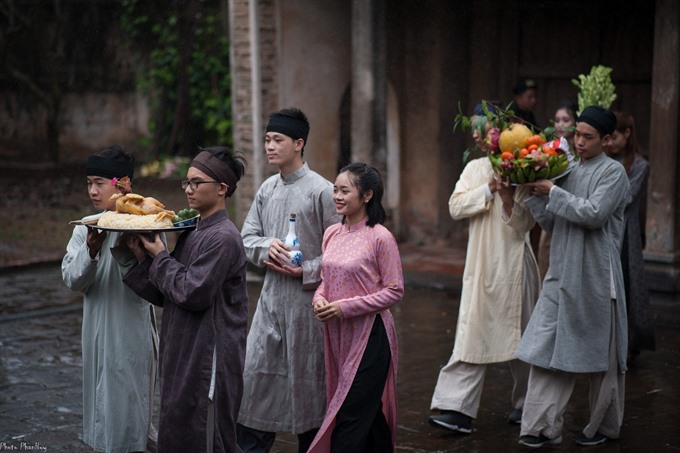 |
| Members of Đình Làng Việt group at a worship ceremony held at So Village’s Communal House. VNS Photo Phan Huy Thiệp |
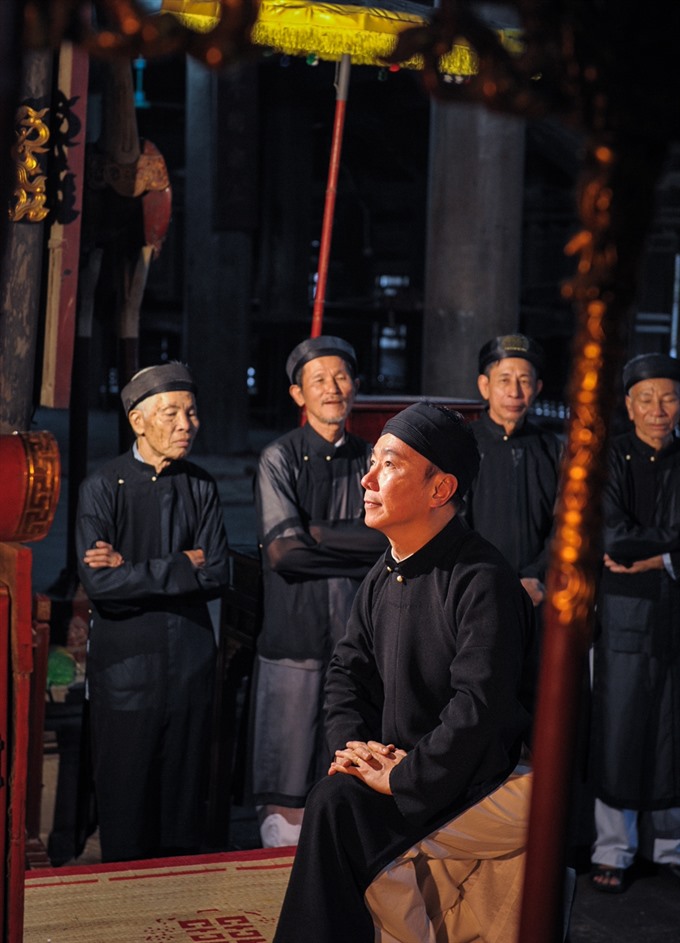 |
| Ambassador Phạm Sanh Châu in an traditional áo dài (front row) at a worship ceremony held at So Village’s Communal House last week. Courtesy Photo of Đình Làng Việt Group |
 |
| Male members of Đình Làng Việt Group pose for a photo in áo dài. VNS Photo Phạm Chính Trung |

